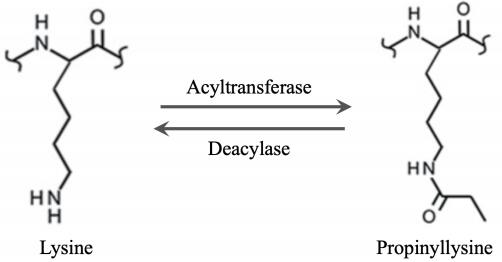Protein Propionylation Analysis
- Potential target identification in drug discovery
- Investigation of gene expression regulation in epigenetics
- Exploration of molecular mechanisms in cellular stress responses
- Studies on metabolic regulation and enzyme activity analysis
Protein propionylation is a post-translational modification (PTM) catalyzed by acyltransferases (e.g., acetyltransferases), in which propionyl groups (such as propionyl-CoA) are covalently attached to lysine residues on proteins. This modification plays a critical role in numerous biological processes, including metabolic regulation, enzyme activity modulation, cellular stress response, and epigenetic control. Recent studies have shown that propionylation not only regulates bacterial metabolic networks but also contributes significantly to the regulation of photosynthesis and stress responses in mammalian cells. Therefore, quantitative analysis of protein propionylation is essential for a deeper understanding of its biological mechanisms and functions.

Figure 1. Protein Propionylation and Depropionylation Process
MtoZ Biolabs is committed to providing high-quality Protein Propionylation Analysis to researchers globally. Leveraging high-resolution mass spectrometry (LC-MS/MS) and advanced antibody enrichment technology, we precisely identify and quantify propionylation modifications on lysine residues of proteins. Our skilled technical team, in combination with cutting-edge mass spectrometry platforms, offers customized service solutions to support a wide range of research needs.
Analysis Workflow

Services at MtoZ Biolabs
1. Targeted Protein Propionylation Analysis
MtoZ Biolabs' targeted protein propionylation analysis service provides precise identification and quantification of propionylation sites on specific proteins using advanced mass spectrometry technology. This service is instrumental in exploring the functional roles of target proteins in diseases, including cancer, metabolic disorders, and neurodegenerative conditions such as Alzheimer's and Parkinson's disease. By offering in-depth insights into protein modifications, this service supports research in understanding disease mechanisms and potential therapeutic targets.
2. Propionylation Proteomics
We offer a comprehensive propionylation proteomics service, utilizing mass spectrometry to analyze propionylation modifications across the entire proteome. This service enables the identification and quantification of hundreds to thousands of propionylation sites, providing valuable insights into their extensive roles in cellular metabolism, gene expression, and signal transduction. Ideal for large-scale studies, this service is particularly suited for research on disease mechanisms, metabolic regulation, and environmental response.
Service Advantages
Why Choose MtoZ Biolabs?
1. Advance Analysis Platform: MtoZ Biolabs established an advanced protein PTM analysis platform, guaranteeing reliable, fast, and highly accurate analysis service.
2. One-Time-Charge: Our pricing is transparent, no hidden fees or additional costs.
3. High-Data-Quality: Deep data coverage with strict data quality control. AI-powered bioinformatics platform integrate PTM proteomics analysis data providing clients with a comprehensive data report.
4. Broad Coverage: By integrating TMT/iTRAQ labeling and Label-Free methods, we offer simultaneous quantitative analysis across multiple samples, enhancing experimental efficiency and ensuring robust data reliability.
5. Customization: Tailored experimental designs and analysis workflows are available to meet specific customer needs, ensuring the most suitable technical support for distinct research objectives.
Sample Submission Requirements

For more sample details, please consult our technical team.
Applications
Deliverables
1. Comprehensive Experimental Details
2. Materials, Instruments, and Methods
3. Total Ion Chromatogram & Quality Control Assessment (project-dependent)
4. Data Analysis, Preprocessing, and Estimation (project-dependent)
5. Bioinformatics Analysis
6. Raw Data Files
MtoZ Biolabs, an integrated chromatography and mass spectrometry (MS) services provider.
Related Services
How to order?







